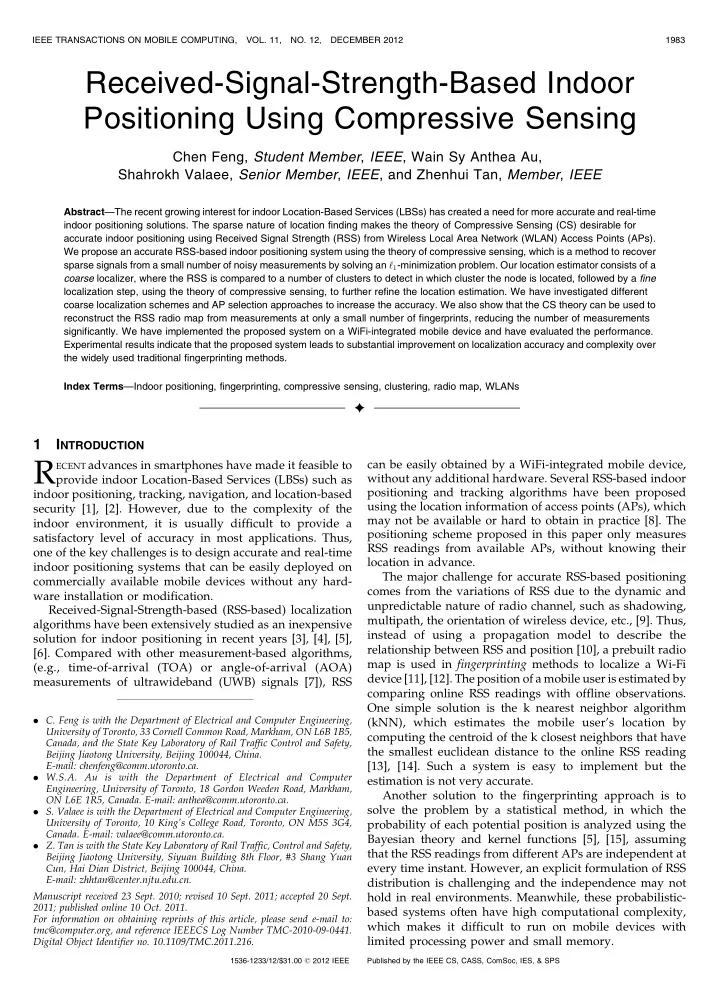

IEEE TRANSACTIONS ON MOBILE COMPUTING, VOL. 11, NO. 12, DECEMBER 2012 1983 Received-Signal-Strength-Based Indoor Positioning Using Compressive Sensing Chen Feng, Student Member , IEEE , Wain Sy Anthea Au, Shahrokh Valaee, Senior Member , IEEE , and Zhenhui Tan, Member , IEEE Abstract —The recent growing interest for indoor Location-Based Services (LBSs) has created a need for more accurate and real-time indoor positioning solutions. The sparse nature of location finding makes the theory of Compressive Sensing (CS) desirable for accurate indoor positioning using Received Signal Strength (RSS) from Wireless Local Area Network (WLAN) Access Points (APs). We propose an accurate RSS-based indoor positioning system using the theory of compressive sensing, which is a method to recover sparse signals from a small number of noisy measurements by solving an ‘ 1 -minimization problem. Our location estimator consists of a coarse localizer, where the RSS is compared to a number of clusters to detect in which cluster the node is located, followed by a fine localization step, using the theory of compressive sensing, to further refine the location estimation. We have investigated different coarse localization schemes and AP selection approaches to increase the accuracy. We also show that the CS theory can be used to reconstruct the RSS radio map from measurements at only a small number of fingerprints, reducing the number of measurements significantly. We have implemented the proposed system on a WiFi-integrated mobile device and have evaluated the performance. Experimental results indicate that the proposed system leads to substantial improvement on localization accuracy and complexity over the widely used traditional fingerprinting methods. Index Terms —Indoor positioning, fingerprinting, compressive sensing, clustering, radio map, WLANs Ç 1 I NTRODUCTION R can be easily obtained by a WiFi-integrated mobile device, ECENT advances in smartphones have made it feasible to without any additional hardware. Several RSS-based indoor provide indoor Location-Based Services (LBSs) such as positioning and tracking algorithms have been proposed indoor positioning, tracking, navigation, and location-based using the location information of access points (APs), which security [1], [2]. However, due to the complexity of the may not be available or hard to obtain in practice [8]. The indoor environment, it is usually difficult to provide a positioning scheme proposed in this paper only measures satisfactory level of accuracy in most applications. Thus, RSS readings from available APs, without knowing their one of the key challenges is to design accurate and real-time location in advance. indoor positioning systems that can be easily deployed on The major challenge for accurate RSS-based positioning commercially available mobile devices without any hard- comes from the variations of RSS due to the dynamic and ware installation or modification. unpredictable nature of radio channel, such as shadowing, Received-Signal-Strength-based (RSS-based) localization multipath, the orientation of wireless device, etc., [9]. Thus, algorithms have been extensively studied as an inexpensive instead of using a propagation model to describe the solution for indoor positioning in recent years [3], [4], [5], relationship between RSS and position [10], a prebuilt radio [6]. Compared with other measurement-based algorithms, map is used in fingerprinting methods to localize a Wi-Fi (e.g., time-of-arrival (TOA) or angle-of-arrival (AOA) device [11], [12]. The position of a mobile user is estimated by measurements of ultrawideband (UWB) signals [7]), RSS comparing online RSS readings with offline observations. One simple solution is the k nearest neighbor algorithm . C. Feng is with the Department of Electrical and Computer Engineering, (kNN), which estimates the mobile user’s location by University of Toronto, 33 Cornell Common Road, Markham, ON L6B 1B5, computing the centroid of the k closest neighbors that have Canada, and the State Key Laboratory of Rail Traffic Control and Safety, the smallest euclidean distance to the online RSS reading Beijing Jiaotong University, Beijing 100044, China. E-mail: chenfeng@comm.utoronto.ca. [13], [14]. Such a system is easy to implement but the . W.S.A. Au is with the Department of Electrical and Computer estimation is not very accurate. Engineering, University of Toronto, 18 Gordon Weeden Road, Markham, Another solution to the fingerprinting approach is to ON L6E 1R5, Canada. E-mail: anthea@comm.utoronto.ca. solve the problem by a statistical method, in which the . S. Valaee is with the Department of Electrical and Computer Engineering, University of Toronto, 10 King’s College Road, Toronto, ON M5S 3G4, probability of each potential position is analyzed using the Canada. E-mail: valaee@comm.utoronto.ca. Bayesian theory and kernel functions [5], [15], assuming . Z. Tan is with the State Key Laboratory of Rail Traffic, Control and Safety, that the RSS readings from different APs are independent at Beijing Jiaotong University, Siyuan Building 8th Floor, #3 Shang Yuan every time instant. However, an explicit formulation of RSS Cun, Hai Dian District, Beijing 100044, China. E-mail: zhhtan@center.njtu.edu.cn. distribution is challenging and the independence may not Manuscript received 23 Sept. 2010; revised 10 Sept. 2011; accepted 20 Sept. hold in real environments. Meanwhile, these probabilistic- 2011; published online 10 Oct. 2011. based systems often have high computational complexity, For information on obtaining reprints of this article, please send e-mail to: which makes it difficult to run on mobile devices with tmc@computer.org, and reference IEEECS Log Number TMC-2010-09-0441. limited processing power and small memory. Digital Object Identifier no. 10.1109/TMC.2011.216. 1536-1233/12/$31.00 � 2012 IEEE Published by the IEEE CS, CASS, ComSoc, IES, & SPS
Recommend
More recommend